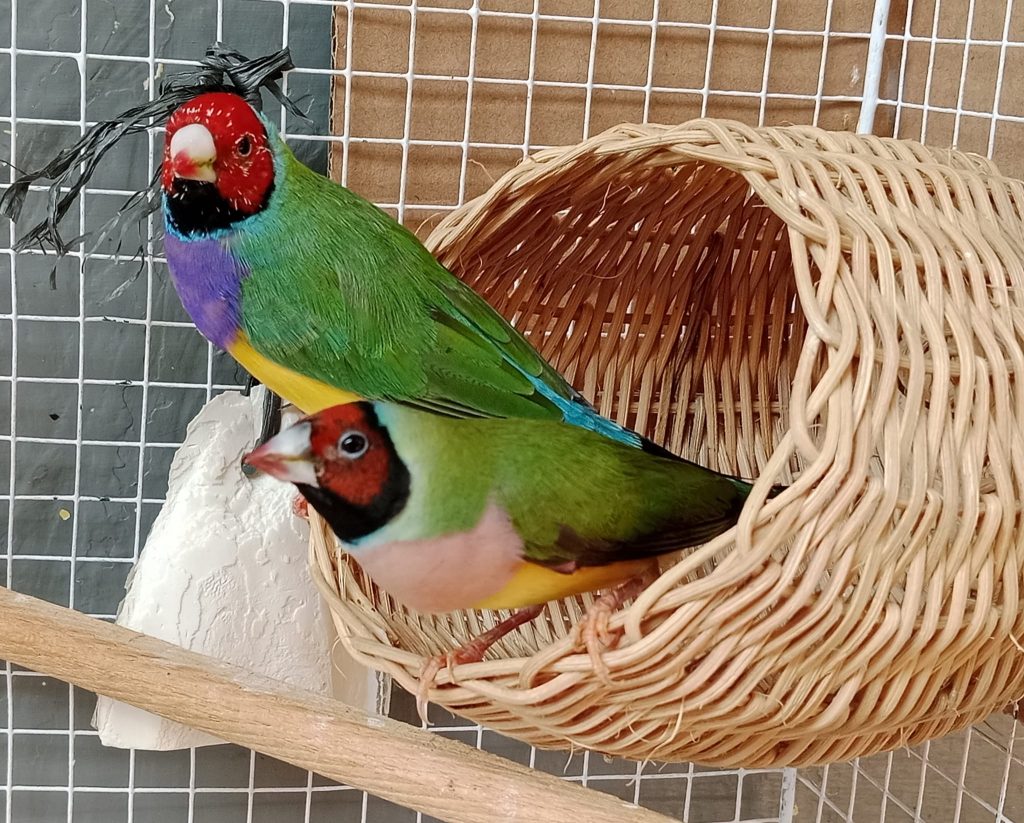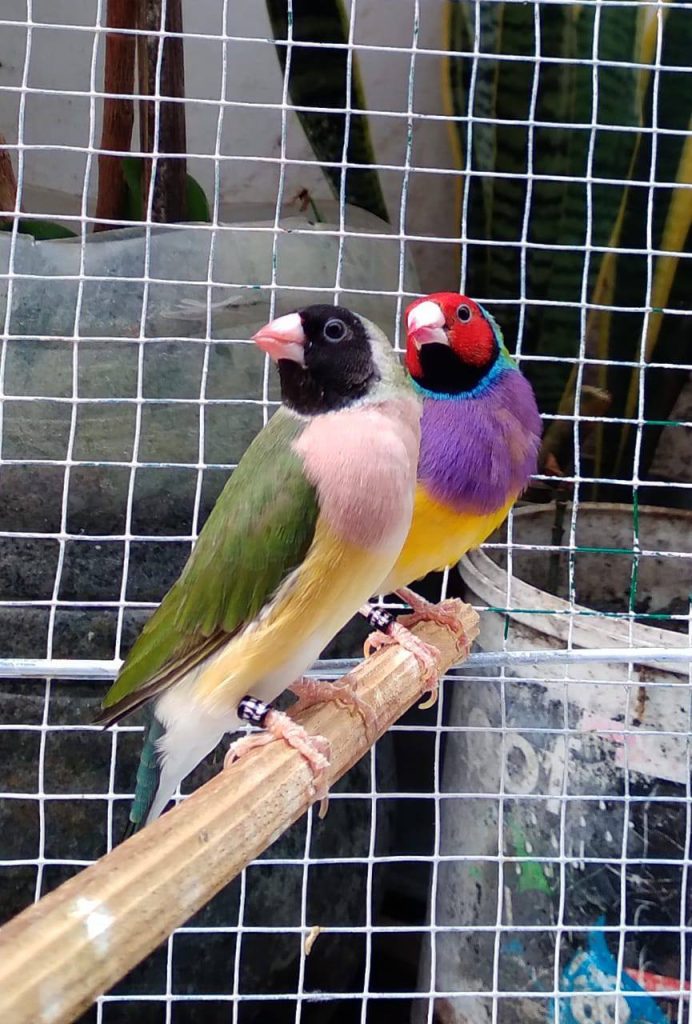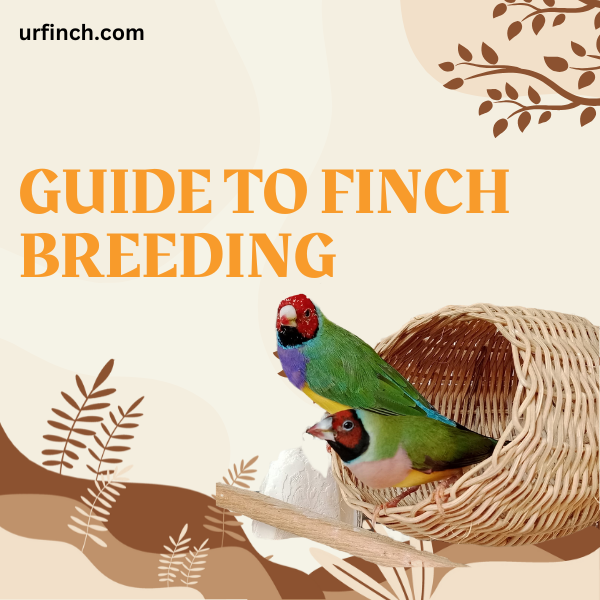If you’re a bird enthusiast or just someone who loves the vibrant beauty of Gouldian Finches, you’ve probably noticed that these little creatures come in a variety of stunning colors. From deep, rich purples to bold, striking greens and yellows, these birds are like living rainbows. But did you know that with careful breeding, you can actually produce specific color morphs of Gouldian Finches? This article is all about breeding Gouldian Finches for color morphs—and how you can get started in this exciting and rewarding hobby.

Why Breed Gouldian Finches for Color Morphs?
Before we dive into the how-to of breeding, let’s talk about why people breed Gouldian Finches for color morphs in the first place.
- Aesthetic Appeal: Gouldian Finches are considered one of the most beautiful bird species in the world. Their colorful plumage is what draws many bird lovers to them. By selectively breeding them for color, you can create your dream bird—whether that’s a striking purple-backed bird or a pastel-colored one.
- Genetics and Understanding: Breeding for color morphs allows bird enthusiasts to get a deeper understanding of avian genetics. Each color variation in a Gouldian Finch is a result of specific genetic traits. Breeding these birds for certain colors involves understanding these traits and experimenting with different pairings.
- Selling and Collecting: If you’re breeding Gouldian Finches for sale, color morphs can increase the appeal of your birds. Collectors love unique and rare color patterns. Breeding finches with specific color traits can help you tap into the niche market of people who are looking for one-of-a-kind birds.
- Conservation Efforts: While Gouldian Finches are endangered in the wild, controlled breeding in captivity can help preserve their gene pool. Selective breeding for color morphs might be a way to maintain a healthy population of these birds, ensuring genetic diversity in captive populations.
Understanding Gouldian Finch Color Morphs
Before you start breeding for color, it’s essential to know what color morphs are out there and what causes them. A color morph refers to a bird’s variation in feather color, pattern, or markings. In the case of Gouldian Finches, these can vary greatly, depending on genetics.
Some of the most common color morphs include:
- Normal (Wild-Type): The wild-type Gouldian Finch has a distinctive color pattern with a green back, red or purple head, yellow belly, and black markings. These birds look like the “classic” Gouldian Finch you’d imagine when you think of them.
- Yellow-Green (Yellow Body): This color morph has a yellow body instead of the usual green, making for a softer, more pastel look. The head can still be red, purple, or black, but the yellow body gives them a different aesthetic.
- Black-Headed Gouldian: In this morph, the bird has a black head instead of the typical purple or red head. This variation is one of the more sought-after traits among breeders due to its unique, striking appearance.
- Red-Headed Gouldian: The red-headed Gouldian Finch has a vibrant, bright red head. This morph is often considered one of the most desirable because the red color contrasts beautifully with the rest of the bird’s plumage.
- Purple-Backed Gouldian: As the name suggests, these birds have a stunning purple back instead of the usual green. The purple coloration can be subtle or deep, depending on genetics.
- White-Breasted Gouldian: This morph is distinguished by a white breast. The rest of the bird’s body remains similar to the wild-type, but the white breast sets them apart from other color variations.
- Pastel Gouldians: These finches have a faded pastel coloration, giving them a soft, delicate look. They usually have pastel versions of green, yellow, and purple.
These are just a few examples of the gorgeous color morphs you can find or breed within the Gouldian Finch species. Each bird’s color is determined by genetic inheritance, meaning that certain traits are passed down from parent birds. Understanding these genes will help you know which pairings to make to achieve your desired color outcomes.
How Does Color Breeding Work?

When breeding for specific color morphs, it’s all about genetics. Gouldian Finches have a dominant and recessive gene structure that affects their coloration. Understanding how these genes work will make your breeding efforts much more successful.
- Dominant vs. Recessive Genes:
- Dominant genes are the ones that show up more frequently in offspring. If a finch carries a dominant gene for a color (e.g., red head), there’s a higher chance that trait will appear in the offspring.
- Recessive genes, on the other hand, are hidden unless both parents carry the gene. If both parents have a recessive trait for a certain color (e.g., purple back), the offspring are more likely to inherit it.
- Color Genetics:
- The red or purple head of the Gouldian Finch, for example, is determined by dominant genes. However, other traits like body color (green, yellow, pastel) can be influenced by recessive genes.
- Some of the more rare morphs (like the black-headed Gouldian Finch) come from mutations that only show up when both parents carry that specific gene.
- Crossbreeding for Color Morphs: To create specific color morphs, breeders often cross different varieties. For example, pairing a red-headed finch with a black-headed finch might result in offspring with a combination of both traits, or you might get some surprising new color patterns. This process of trial and error, combined with careful observation of offspring, is key to achieving specific color morphs.
The Steps to Breeding Gouldian Finches for Color Morphs
Now that you know a bit about the color genetics, let’s talk about the actual breeding process. Breeding Gouldian Finches for color morphs is both an art and a science. If you’re serious about creating your ideal finch, here’s a step-by-step guide:
1. Choose Healthy Breeding Pairs
Before you even think about color morphs, you need to make sure your breeding birds are healthy. Select finches that are in their prime, not too old and not too young. Healthy birds will give you the best chance of successful breeding.
2. Research the Genetics
To achieve the color morphs you want, it’s essential to understand the genetics behind the colors. Do some research into the genetic traits associated with each color. Once you have a good understanding, you can plan your pairings accordingly.
For example, if you want to create a purple-backed finch, you’ll need to find birds that carry the recessive gene for that trait. Pairing two purple-backed birds will increase your chances of getting offspring with that same color.
3. Prepare the Breeding Environment
Gouldian Finches need a specific environment to breed successfully. They prefer warm temperatures and a calm, stress-free environment. Set up a spacious breeding cage with lots of nesting material (such as soft grasses, cotton, and coconut fibers) for the female to build a nest. Make sure the cage is clean, and there’s access to fresh water and food.
4. Monitor the Birds During the Breeding Season
During the breeding season, which usually happens in the spring and summer months, the female Gouldian Finch will begin to show signs of wanting to breed, like nesting behaviors. Keep a close eye on the pair, as Gouldian Finches can sometimes be picky when it comes to selecting mates. If the pair isn’t getting along, you may need to try a different combination.
5. Observe the Offspring
Once the eggs hatch, observe the offspring closely. Take note of their colors and how they compare to the parents. In some cases, the color morphs may appear immediately, while in other cases, it might take a little longer for the colors to fully develop.
6. Continue Selective Breeding
Selective breeding takes time. If you want to perfect a particular color morph, you’ll need to continue breeding over multiple generations. By carefully selecting the best-colored birds from each clutch and pairing them for the next round of breeding, you can continue to improve the color intensity and overall quality of your finches.
7. Common Challenges in Breeding Gouldian Finches for Color Morphs
While breeding Gouldian Finches for color morphs is exciting, it’s not always smooth sailing. There are a few challenges you might face as a breeder, but with patience and perseverance, they can be overcome. Let’s take a look at some common issues:
a. Compatibility Between Birds
Not every Gouldian Finch will get along with every other finch, and sometimes even birds that are genetically compatible won’t mate. If you’re trying to breed for a specific color morph, you might face compatibility issues between your breeding pairs. Some finches may not be interested in mating, or the male and female may fight, especially if they are not accustomed to each other.
- Solution: Try pairing birds that have been living together for some time, as they’ll be more likely to bond. Also, ensure that your breeding cage is large enough to give them personal space, reducing the chance of aggressive behavior. If one pair isn’t working out, try different combinations until you find the right match.
b. Infertility or Poor Hatch Rates
Breeding finches is not always guaranteed to result in healthy eggs. Sometimes, even when everything seems perfect, eggs can be infertile or not hatch at all. Low fertility rates or poor hatch success can be frustrating, especially if you’re working towards specific color morphs.
- Solution: Ensure your finches are receiving a balanced diet rich in vitamins and minerals, especially calcium, which is essential for egg production and health. If you notice a low hatch rate, try adding extra protein to their diet, such as boiled eggs or small amounts of live food like mealworms. Proper nesting conditions (temperature, humidity, and cleanliness) are also crucial to successful breeding.
c. Genetic Issues and Health Problems
When you focus on breeding for a specific color morph, you can sometimes unintentionally introduce genetic issues into your birds. Some color morphs, particularly the rarer ones, may carry genetic mutations that affect the bird’s health.
- Solution: While breeding for specific colors, always aim to maintain a healthy gene pool. Avoid inbreeding by bringing in fresh bloodlines from other breeders regularly. If you notice any health issues with your birds, such as weak immune systems or deformities, consider reevaluating your breeding strategy. Regular checkups with an avian vet can also help catch any health problems early.
d. Color Inconsistencies
Even when breeding for specific color morphs, there’s a chance that the offspring won’t match the desired color exactly. This is because the genetic combinations can sometimes lead to unexpected results, especially if recessive genes are involved.
- Solution: Be prepared for some color variations, especially if you’re working with a mix of dominant and recessive genes. This unpredictability is part of the fun of breeding, but if you want more control over the color results, you may need to spend more time perfecting your breeding techniques over multiple generations. Keep detailed records of your pairings and offspring so that you can better predict and select future breeding pairs.
8. Maintaining the Health of Your Gouldian Finches
Breeding for color morphs is exciting, but your birds’ health should always come first. Healthy birds not only breed more successfully but also live longer, happier lives. Here are some tips to ensure your Gouldian Finches stay in top shape:
a. Balanced Diet
A balanced diet is key to the health of your Gouldian Finches. In the wild, they eat a variety of seeds, fruits, and small insects. For captive birds, you’ll need to provide a similar diet:
- Seeds: Offer a high-quality seed mix that includes millet, canary seeds, and other small seeds. Gouldian Finches tend to prefer a mix with a variety of colors and textures.
- Fresh Vegetables and Fruits: Provide fresh, chopped veggies like spinach, carrot tops, dandelion leaves, and broccoli. Small amounts of fruit like apple or pear can also be offered, but be careful not to overfeed fruits that are too sugary.
- Egg Food: During breeding season, finches require extra protein. You can provide boiled eggs or egg food (a powdered mix available at pet stores) to boost their nutrition.
- Supplements: Consider adding calcium supplements to their diet, especially for females laying eggs, to prevent egg binding and promote healthy bones.
b. Cage Setup and Environment
Gouldian Finches thrive in an environment that mimics their natural habitat. They’re used to warm temperatures and like to have a variety of perches, hiding places, and things to explore. Here’s how to set up the perfect breeding environment:
- Temperature: Gouldian Finches need a temperature between 70°F and 85°F (21°C – 29°C). They are tropical birds, so avoid drafts and cold temperatures.
- Perches: Use natural wooden perches of varying sizes to keep their feet healthy. Avoid plastic perches, as they can cause foot problems.
- Nesting Boxes: Provide small, sheltered nesting boxes with soft materials for them to build their nests. The females are usually the nest builders, so make sure there’s plenty of soft grass, coconut fibers, and cotton available.
- Privacy: Gouldian Finches can be a bit shy, especially when breeding. Ensure that the breeding pair has a quiet, stress-free environment away from too much human activity.
c. Regular Health Checks
Keep an eye on your finches for any signs of illness. Symptoms like lethargy, changes in droppings, or unusual behavior may indicate health issues. If you’re unsure, always consult an avian vet who specializes in small birds. A health checkup is especially important before you breed them, as it ensures that the birds are in good condition and ready for mating.
9. Advanced Breeding Techniques for Color Morphs
Once you’re comfortable with the basics of Gouldian Finch breeding, you can try some advanced techniques to really perfect your color morphs. Here are a few tips for experienced breeders:
a. Line Breeding
Line breeding is a method where you selectively breed birds that are closely related but not too closely (i.e., not siblings). This technique helps to fix certain traits, such as color morphs, in the gene pool over generations.
For example, if you want to create a specific color pattern, you can line breed birds with the same or similar color traits. Over several generations, this increases the likelihood that the color traits will become more prominent in the offspring.
b. Outcrossing
Outcrossing involves breeding two birds from different lines or bloodlines to introduce new genetic material. This helps to prevent inbreeding and maintain healthy genetics in the population. Outcrossing is especially important if you notice that some of your birds are developing genetic problems.
While outcrossing might result in a mix of colors in the offspring, it can also bring new and exciting color morphs into your breeding program. It’s a good strategy if you want to maintain the health of your birds while still focusing on specific colors.
c. Selective Breeding for Traits Beyond Color
If you’re interested in more than just color, you can also select for other traits like size, feather quality, or temperament. For example, you might want to breed birds that are more social or have longer lifespans. By tracking these traits, you can create not just beautiful birds, but birds that thrive in captivity.
10. Selling or Showcasing Your Colorful Gouldian Finches
Once you’ve successfully bred some stunning color morphs, you might want to sell or showcase your birds. Here are some tips for doing so:
a. Build a Reputation
If you plan to sell your finches, make sure to build a reputation as a responsible and knowledgeable breeder. Many buyers are looking for healthy, well-cared-for birds, and they’ll appreciate breeders who take the time to properly care for their flock. Be transparent about your breeding practices and provide buyers with information about the birds’ genetics, diet, and care.
b. Enter Bird Shows
Bird shows are a great way to showcase your beautifully bred Gouldian Finches and connect with other breeders. Competitions often judge birds based on color, feather quality, and overall health, so it’s a great way to gain recognition for your hard work. Make sure to keep your birds in top condition and prepare them for the show in advance.
c. Online Sales and Social Media
In today’s world, selling birds online can be a great way to reach a wider audience. Websites like Bird Breeders, Birds for Sale, and social media platforms like Instagram or Facebook can help you connect with people who are looking for unique color morphs. Just be sure to check your local laws and regulations about selling birds.
Challenges of Breeding for Color Morphs
While breeding for color morphs is exciting, it’s not without its challenges. Here are a few things to keep in mind:
- Genetic Diversity: If you focus too much on one color morph, you might limit the genetic diversity of your flock. This can lead to inbreeding and health problems in the long run. It’s important to balance your breeding goals with maintaining genetic diversity.
- Health Risks: Some color morphs may be linked to health issues. For example, certain mutations that create more intense colors can lead to weaker immune systems or other health problems. Always monitor the health of your birds closely and be mindful of the potential risks associated with breeding for specific traits.
- Time and Patience: Breeding for color morphs is a long-term project. It can take years of careful planning, observation, and pairing to produce the perfect bird. Be prepared to invest time and patience.
Conclusion: The Joy of Breeding Gouldian Finches for Color Morphs
Breeding Gouldian Finches for color morphs is an incredibly rewarding hobby. Not only do you get to watch these beautiful birds thrive, but you also get the satisfaction of creating unique, colorful birds that are a testament to your breeding knowledge and efforts.
Whether you’re just starting out or you’ve been breeding finches for years, understanding the genetics behind color morphs will help you create the birds you envision. With the right care, knowledge, and patience, you can enjoy the process of watching your colorful finches grow and flourish. Plus, who doesn’t love having a little rainbow in their birdcage?
So, if you’re ready to embark on your breeding journey, grab a pair of finches, get to know their genetics, and start creating your own flock of gorgeous Gouldian Finches!

